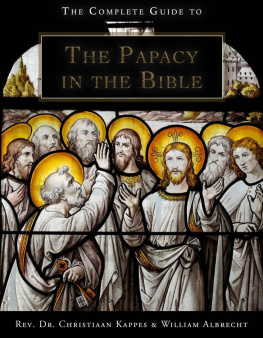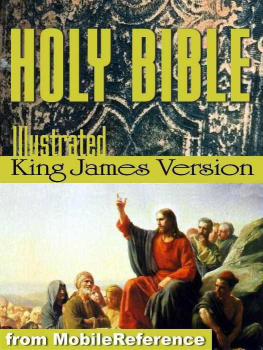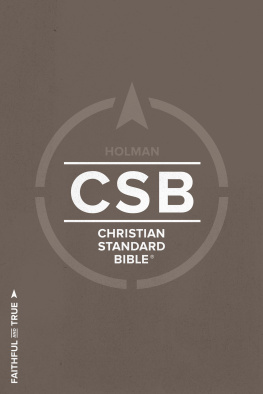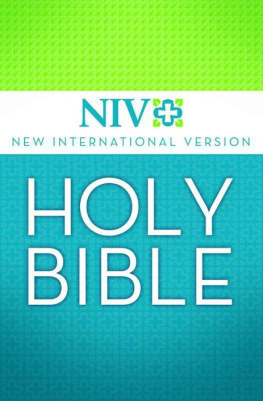Christiaan Kappes - The Complete Guide to the Papacy in the Holy Bible
Here you can read online Christiaan Kappes - The Complete Guide to the Papacy in the Holy Bible full text of the book (entire story) in english for free. Download pdf and epub, get meaning, cover and reviews about this ebook. year: 2022, publisher: Patristic Pillars press, genre: Religion. Description of the work, (preface) as well as reviews are available. Best literature library LitArk.com created for fans of good reading and offers a wide selection of genres:
Romance novel
Science fiction
Adventure
Detective
Science
History
Home and family
Prose
Art
Politics
Computer
Non-fiction
Religion
Business
Children
Humor
Choose a favorite category and find really read worthwhile books. Enjoy immersion in the world of imagination, feel the emotions of the characters or learn something new for yourself, make an fascinating discovery.
- Book:The Complete Guide to the Papacy in the Holy Bible
- Author:
- Publisher:Patristic Pillars press
- Genre:
- Year:2022
- Rating:4 / 5
- Favourites:Add to favourites
- Your mark:
- 80
- 1
- 2
- 3
- 4
- 5
The Complete Guide to the Papacy in the Holy Bible: summary, description and annotation
We offer to read an annotation, description, summary or preface (depends on what the author of the book "The Complete Guide to the Papacy in the Holy Bible" wrote himself). If you haven't found the necessary information about the book — write in the comments, we will try to find it.
The Complete Guide to the Papacy in the Holy Bible — read online for free the complete book (whole text) full work
Below is the text of the book, divided by pages. System saving the place of the last page read, allows you to conveniently read the book "The Complete Guide to the Papacy in the Holy Bible" online for free, without having to search again every time where you left off. Put a bookmark, and you can go to the page where you finished reading at any time.
Font size:
Interval:
Bookmark:
The Complete Guide to the Papacy in the Holy Bible
Biblical Dogmatics Vol. 3
Rev. Dr. C. Kappes and William Albrcht
Patristic Pillars Press

Copyright 2022 Patristic Pillars
All rights reserved
No part of this book may be reproduced, or stored in a retrieval system, or transmitted in any form or by any means, electronic, mechanical, photocopying, recording, or otherwise, without express written permission of the publisher.
ISBN-13: 9781234567890
ISBN-10: 1477123456
Cover design by: Notre Dame de Beaune basilica used with permission
Library of Congress Control Number: 2018675309
Printed in the United States of America
Contents
The Complete Guide to the Papacy in the Holy Bible
Biblical Dogmatics Vol. 3
By Rev. Dr. Christiaan Kappes & William Albrecht
Foreword
We deemed it necessary to produce this focused study so that any educated pilgrim may understand in plain and straightforward English just how dedicated the Gospels (as well as Acts of the Apostles and some Pauline epistles) are to providing the written constitution of St. Peters office in the early Church, which was subsequently taken as the model and constitution for what is the papal office among the successors of St. Peter. It goes without saying that any discussion about the authority and office of St. Peter the Apostle in the New Testament eventually requires an inquirer to center on St. Peters confession of faith at Caesarea Philippi. This study shall successfully put to rest concerns over alleged ambiguities in Petrine verses, as well as highlight otherwise unknown sources used principally by St. Matthew the Evangelist, among other Evangelists and epistolary writers, to demonstrate the biblical doctrine regarding St. Peters office and its divine constitution for the fledgling Church. Concepts like jurisdiction, as well as doctrinal and moral authority, are part and parcel of St. Peters office in the mind of Jesus and the authors of the Gospels. This assertion will be evidenced as entirely harmonious with Scripture and cognizant of scholarly work, original sources, and textual criticism, not to neglect patristic literature relevant to the current discussion. In our use of Scripture, with a knowledge of original languages and more detailed translations, the reader should expect departure from the New King James Version as a regular course of action. On occasion, we have used another translation in print (e.g., NIV) because it is close to the literal sense, but even this may be altered to better reflect a nuance in the original language. Regarding the use of NKJV, its advantage is in being a literal rendering of the Hebrew and Greek, along with some erroneous readings (according to lower critics) found in prior editions of the King James Version. The NKJV has the advantage of being an acceptable text for many Christians who are in the Reformed tradition, while also using a text not too dissimilar from the Byzantine text form, which represents the Greek text of the New Testament used liturgically in both Eastern Orthodox and Eastern Catholic Churches whose language is entirely Greek. Under the rubric: traslatore, traditore or one who translates is one who betrays, the authors acknowledge that each English translation from a text not originally composed in modern English is, to whatever degree, untranslatable and, therefore, taste and discretion are needed since science is but limited in this regard. Mr. William Albrcht has entrusted this discretion to Rev. Dr. Kappes who has published English translations of Latin and Greek works in peer reviewed and scientific journals and books. Regarding Hebrew and Aramaic, no new translations were provided but the texts herein have been altered by comparing published materials with each other and/or Hebrew or Aramaic vocabulary at the root of the English translation, sometimes leading to slight emendations to bring clarity to each discussion. The authors welcome all critiques of the choices made to improve the present work. It may be edited in its electronic version in the future as deemed fit. While, in keeping with scholarship, the substance and philological points of each argument are deemed at least plausible or probable (when not morally certain), there is always room for improvement when translating materials. It is hoped that the reader will not be exasperated for want of a single English edition for convenient reference of every passage of Scripture below. This book would not be possible were we trapped into providing a published text and slavish adherence thereto, when no translation can ever capture the nuances and background of the original language in a single English rendering, especially considering newly published scholarly data since the date of publication of any one translation; potentially clarifying passages of the Bible that were formerly obscure to modern readers. In a like manner, we have corrected and adjusted published English translations of some patristic texts either to better conform to the original language or to update an arcane term that obscures the meaning of the text for modern readers. Also, for those unfamiliar with convention on citations: [square brackets] signify that a quotation has an implication, or comment, inserted into the original text, while (parenthesis) is designates a grammatical convention of English that is present in the original language of the translation provided. If a translation has not been cited by the authors (besides the aforementioned versions of the Scriptures), then the reader may assume that the translation is our own.
Introduction
If we imagine for a moment an expert painter working on an icon of the Apostle Peter, as the artist crafts his work bit by bit, the icon comes to life out of the imagination of the master artist onto the panel of wood. Over the course of time, the master painter or icon writer begins to give people a representation of him upon whom they can look and meditate in holy thought and prayer. Just like the icon, slowly coming to life through the hand of the artist, such is the role laid out in Sacred Scripture for one Simon Peter in the hand of the Master, Jesus Christ. Our present study desires to go where other studies have not gone, that is, in-depth in terms of synthesizing the powerful evidences of the magnificent role of St. Peter from Sacred Scripture. Our icon of St. Peter presents the very person that Jesus Christ chose to be the shepherd of his flock. This portrait comes to life piece by piece as we progress along our journey, examining the role laid out for him and his successors as evidenced in the Scriptures and holy authors that wrote their commentaries based upon the histories therein. To begin by quoting an older theologian of repute, Dr. Ludwig Ott notes the incredible importance of the role of Saint Peter in Sacred Scripture:
From the very beginning Christ distinguished the Apostle Peter from the other Apostles. At the first meeting He announced the change of his name from Simon to Cephas = rock: Thou art Simon the son of John. The name Cephas indicates the office to which the Lord had appointed him
The Early Church Fathers understood Saint Peters important role and perhaps no Father better describes the incredible gift bestowed upon the Apostle than the great Doctor and Father of the Church, Saint Augustine:
Is it a great thing that he changed his name and made him Peter from Simon? Now Peter is from the word for rock, but the rock is the church. Therefore, in the name of Peter the church was represented. And who is secure if not he who builds on a rock? And what does the Lord himself say? He who hears these words of mine and does them, I shall liken him to a wise man who builds on rock.
Next pageFont size:
Interval:
Bookmark:
Similar books «The Complete Guide to the Papacy in the Holy Bible»
Look at similar books to The Complete Guide to the Papacy in the Holy Bible. We have selected literature similar in name and meaning in the hope of providing readers with more options to find new, interesting, not yet read works.
Discussion, reviews of the book The Complete Guide to the Papacy in the Holy Bible and just readers' own opinions. Leave your comments, write what you think about the work, its meaning or the main characters. Specify what exactly you liked and what you didn't like, and why you think so.













